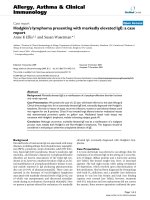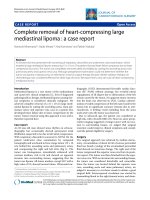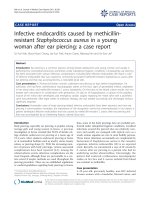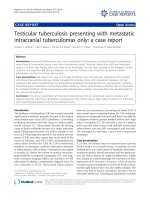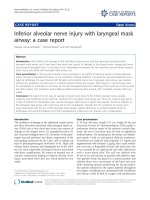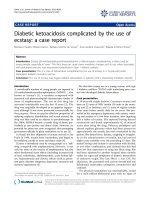Báo cáo y học: "Infective endocarditis caused by methicillinresistant Staphylococcus aureus in a young woman after ear piercing: a case report" docx
Bạn đang xem bản rút gọn của tài liệu. Xem và tải ngay bản đầy đủ của tài liệu tại đây (232.43 KB, 3 trang )
CAS E RE P O R T Open Access
Infective endocarditis caused by methicillin-
resistant Staphylococcus aureus in a young
woman after ear piercing: a case report
So-Yun Nah, Moon-Hyun Chung, Jae Eun Park, Areum Durey, Mijeong Kim and Jin-Soo Lee
*
Abstract
Introduction: Ear piercing is a common practice among Korean adolescents and young women and usually is
performed by nonmedical personnel, sometimes under suboptimal hygienic conditions. Conseque ntly, ear piercing
has been associated with various infectious complications, including fatal infective endocarditis. We report a case
of infective endocarditis that was caused by community-associated methicillin-resistant Staphylococcus aureus after
ear piercing and that was accompanied by a noticeable facial rash.
Case presentation: A 29-year-old Korean woman underwent ear piercing six days before hospitalization. On
admission, she had fever, erythematous maculopapular rashes on her face, signs of generalized emboli, vegetation
in her mitral valve, and methicillin-resistant S. aureus bacteremia. On the basis of the blood culture results, she was
treated with vancom ycin in combination with gentamicin. On day six of hospitalization, a rupture of the papillary
muscle of her mitral valve developed, and emergency cardiac surgery replacing her mitral valve with a prosthetic
valve was performed. After eight weeks of antibiotic therapy, she was treated successfully and discharged without
significant sequelae.
Conclusions: Numerable cases of body piercing- related infective endocarditis have been reported, and since ear
piercing is commonplace nowadays, the importance of risk recognition cannot be overemphasi zed. In our report, a
patient developed infective endocarditis that was caused by methicillin-resistant S. aureus after ear piercing and
that was accompanied by an interesting feature, namely facial rash.
Introduction
Body piercing, especially ear piercing, is popular among
teenage girls and young women in Korea. A previous
investigation in Korea revealed that 96.5% of female col-
lege students underwent ear piercing at a mean age of
19.3 years. Most students underwent piercing at home
or at nonmedical facilities such as jewel ry stores, beaut y
salons, or piercing shops [1]. With the increasing num-
ber of persons with body piercings, various associated
complications have been reported [2,3]. Among the
related a dverse events, infectious complications are the
most frequent, although these are preventable to a cer-
tain extent if aseptic methods are used throughout the
piercing procedure. There are no established regulations
or medical guidelines regarding body piercing in Korea;
thus, some of the body piercings here are probably per-
formed under subopti mal hygienic conditio ns. Localized
infections around the pierced sites are relatively com-
mon and usually are managed with topical care; as a
result, serious sequelae are rare in most healthy persons.
These minor infections occasionally are complicated by
bacteremia; if Staphylococcus aureus is the causative
organism, infective endocarditis (IE) is an expected
event. Recently, we encountered a case of IE caused by
S. aureus after ear piercing in a patient who had no
underlying cardiac abnormalities. Interestingly, the
patient had scattered erythematous maculopapular
rashes on her face and S. aureus isolated from blood
was resistant to methicillin.
Case presentation
A 29-year-old, previously healthy, non-HIV-infected
Korean woman with a headache, blurred vision, and
* Correspondence:
Department of Internal Medicine (Infectious Diseases), Inha University
Hospital, Incheon City, Joong-gu, Sinheung-dong 3, Republic of Korea
Nah et al. Journal of Medical Case Reports 2011, 5:336
/>JOURNAL OF MEDICAL
CASE REPORTS
© 2011 Nah et al; lic ensee BioMed Central Ltd. This is an Open Access article distributed under the terms of the Creative Commons
Attribu tion License ( which perm its unr estricted use, distribution, and reproduction in
any medium, provided the original work is properly cited.
fever was admitted to our hospital. She had no history
of intravenou s (IV) drug use, vascu lar catheter use, acu-
puncture, or any significant medical condition such as
congenital heart disease. She had gotten her earlobes
pierced at a beauty salon six days before admission.
On admission, her body temperature was 38.4°C, her
blood pressure was 108/63 mm Hg, her heart rate was
83 beats per minute, and her respiratory rate was 18
breaths per minute. The puncture sites on both earlobes
were tender without sig ns of inflammation. Various skin
lesions were noted: nonpruritic maculopapular rashes
on her fac e, multiple Janeway lesions an d pustules on
her palms and soles, scattered pustules and microabs-
cesses on her trunk and extremities, and subungual
splinter hemorrhages o n her fingers. Subconjunctival
hemorrhage was also observed; a slit-lamp examination
revealed multiple Roth spot-like retinal hemorrhages.
Her lung sounds were c lear, and no cardia c murmur
was audible. Bilateral costove rtebral angle tenderness
was noted. No remarkable neurological abnormalities,
except for blurred vision, were present. Laboratory tests
revealed microscopic hematuria and the following
values: white blood cell (WBC) count of 7170 cells/μL,
platelet count of 60,000 cells/μL, C-reactive protein level
of 260 mg/L, and an erythrocyte sedimentation rate of
10 mm/hour. A cerebrospinal fluid (CSF) analysis
revealed red blood cell and WBC counts of 100 and 520
cells/μL (71% neutrophils and 2% lymphocytes), respec-
tively; a CSF protein level of 84 mg/dL; and a glucose
level of 61 mg/dL. An electrocardiogram revealed no
abnormalities except for sinus tachycardia and right axis
deviation. A chest radiography did not reveal any speci-
fic abnormality. A transthoracic echocardiography per-
formed on day two of hospitalization revealed vegetation
attached to the anterior chordae of her mitral valve; no
intracardiac thrombi or structural cardiac abnormalities
were observed. Brain magnetic resonance imaging
revealed multiple embolic infarcts and leptomeningeal
enhancement in both hemispheres of her cerebrum and
cerebellum. An abdominal computed tomography (CT)
scan revealed hypoattenuated lesions in her spleen and
kidneys, suggesting the presence of multiple embolic
infarcts with abscesses. S. aureus isolated from three
sets of blood cultures was resistant to penicillin and
oxacillin but was susceptible to gentamicin, clindamycin,
erythromycin, ciprofloxacin, and trimethoprim-sulfa-
methoxazole. On the basis of the blood culture results,
initial therapy with nafcillin and ceftriaxone was substi-
tuted with vancomycin in combination with gentamicin.
On day eight of hospitalization, gentamicin treatment
was discontinued.
On day s ix of hospital ization, our patient developed
dyspnea and hypotension; a transthoracic echocardiogra-
phy revealed a rupture of the papillary muscle of her
mitral valve. An intra-aortic balloon pump was
implanted, after which emergency cardiac surgery con-
firmed vegetation in the ventricular side of her P 3 scal-
lop and a rupture of her mitral valve chordae. Her
entire mitral valve, including the base of her medial
papillary muscle, was removed and replaced with a pros-
thetic valve. After eight weeks of vancomycin therapy,
our patient was discharged without significant sequelae.
Her facial rashes disappeared completely. In a tran seso-
phageal echocardiography performed before discharge,
her prosthetic mitral valve was found to be functioning
well; follow-up brain and abdominal CT scans indicated
an improvement in her condition.
Discussion
Serious infections associated with body piercing are rare;
however, there has been a rise in the incidence of IE
resulting from piercing of various body parts [4]. Out of
the 22 cases of body piercing-related IE summarized by
Armstrong and colleagues [4], three repo rts that were
tattoo-related or lacked detailed information were
excluded from our l iter ature survey. A tot al of 23 cases,
including three cases [5-7] and the present case,
revealed that the most frequently identified causative
organism was S. aureus (11 cases) followed by Strepto-
coccus species (five cases), Staphylococcus epidermidis
(two cases), and Haemophilus aphrophilus, H. parain-
fluenzae,andNeisseria mucosa (one case each); and
blood cultures yielded negative results in two cases. In
regard to the antibiotic susceptibility of S. aureus,nine
cases involved infection with methi cillin-susc eptible and
two with methicillin-resistant S. aureus (MRSA). MRSA
infection in persons not exposed to hospital or health-
care settings (that is, community-associated MRSA, or
CA-MRSA) is increasingly being reported in Korea and
is mainly isolated in the form of skin and soft-tissue
infections or ear infections [8]. With the community-
wide dissemination of MRSA, an increase in the inci-
dence of endocarditis caused by CA-MRSA is expected.
However, this condition is still uncommon and occurs
primarily in IV drug users or individuals with soft-tissue
infections [9]; there was only one case report of CA-
MRSA-induced IE in Korea until 2009 [10]. Despite its
rare occurrence, IE caused by CA-MRSA has been
found in two out of 11 patients with body piercing-
related S. aureus endocarditis; thus, the present case
suggests that body piercing may be a risk factor for the
development of CA-MRSA infection. Body piercing has
several features in common with IV drug use: the use of
sharp objects by nonmedical persons, close physical con-
tact, the high risk of minor skin infections, and, possibly,
self-management with antiseptics or antibiotics.
In our patient, we noted a characteristic facial rash,
which has never been reported in IE cases associated
Nah et al. Journal of Medical Case Reports 2011, 5:336
/>Page 2 of 3
with ear piercing or piercing of other body part s. Also,
there was an interesting similarity between the present
case and a case reported by us in 2006 [1]; both patients
contracted S. aureus endocarditis of the mitral v alve
after having thei r ears pierce d and developed an erythe-
matous maculopapular rash on the face in addition to
signs of generalized emboli, and the rash disappeared
after successful treatment of IE with antibiotics in b oth
cases.
Although the pathogenesis of cutaneous stigmata asso-
ciated with IE, such as Osler nodes or Janeway lesions,
has been debated, it is now clear that septic emboli are
mainly involved in the development of these stigmata
[11]. This explains the manifest ation of stigmata at sites
remote from the heart, usually the terminal phalanges of
the fingers and toes and the soles or the palms. On the
other h and, the rash in our cases developed in the face
exclusively, suggesting the possibility of a mechanism
different from that of cutaneous stigmata due to septic
embolism (for example, lymphatic spread).
Conclusions
Among 23 cases of piercing-related IE, only the two
cases reported by us mentioned a facial rash; therefore,
we assumed that left-sided IE caused by S. aureus after
ear piercing led to fa cial rash development. Besides
developing septic emboli, our patients developed diffu-
sely scattered, minute erythematous maculopapules,
exclusively on the face. The known cause of facial rash
after ear piercing is an allergic reaction or localized bac-
terial infections around the pierced site. Localized dif-
fuse erythema, mainly a round a pierced site, may be
noted in staphylococcal toxic shock syndrome [2,3]. No
case of scattered maculopapular rashes on the whole
face has been reported, even amon g patients who devel-
oped S. aureus bacteremia after ear piercing [12,13]. We
assumedthattheunderlyingmechanism differed from
that of septic embolism and that S. aureus sp read possi-
bly via lymphatics. Regardless of the precise mechanism
of facial rash development, the presence of a facial rash
in a person with sepsis or septic embolism (or both)
after ear pier cing suggests t he possibility o f left-sided
valve IE caused by S. aureus, even if echocardiography
performed at an early stage does not reveal valvular
abnormalities or vegetation.
Consent
Written informed consent was obtained from the patient
for publicatio n of this case report and any accompany-
ing images. A copy of the writ ten consent is available
for review by the Editor-in-Chief of this journal.
Abbreviations
CA-MRSA: community-associated methicillin-resistant Staphylococcus aureus;
CSF: cerebrospinal fluid; CT: computed tomography; IE: infective endocarditis;
IV: intravenous; MRSA: methicillin-resistant Staphylococcus aureus; WBC: white
blood cell.
Authors’ contributions
S-YN was primarily responsible for drafting, submitting, and revising the
manuscript and conducting the literature search. M-HC and J-SL critically
revised the manuscript for important intellectual content and gave final
approval of the version to be published. JEP, AD, and MK assisted in the
patient management and literature review. All authors read and approved
the final manuscript.
Competing interests
The authors declare that they have no competing interests.
Received: 13 September 2010 Accepted: 1 August 2011
Published: 1 August 2011
References
1. Lee SH, Chung MH, Lee JS, Kim ES, Suh JG: A case of Staphylococcus
aureus endocarditis after ear piercing in a patient with normal cardiac
valve and a questionnaire survey on adverse events of body piercing in
college students of Korea. Scand J Infect Dis 2006, 38:130-132.
2. Stirn A: Body piercing: medical consequences and psychological
motivations. Lancet 2003, 361:1205-1215.
3. Samantha S, Tweeten M, Rickman LS: Infectious complications of body
piercing. Clin Infect Dis 1998, 265:735-740.
4. Armstrong ML, DeBoer S, Cetta F: Infective endocarditis after body art: a
review of the literature and concerns. J Adolesc Health 2008, 43:217-225.
5. Dubose J, Pratt JW: Victim of fashion: endocarditis after oral piercing. Curr
Surg 2004, 61:474-477.
6. Nunes Mdo C, Barbosa FB, Gelape CL, Leduc LR, Castro LR, Gresta LT,
Ferrari TC: Piercing-related endocarditis presenting with multiple large
masses in the right-side chamber of the heart. J Am Soc Echocardiogr
2008, 21:776.e1-3.
7. Giuliana B, Loredana S, Pasquale S, Giovanna P, Giorgio C, Laura C,
Pellegrino A, Paolo N, Luigi C, Massimo A: Complication of nasal piercing
by Staphylococcus aureus endocarditis: a case report and a review of
literature. Cases J 2010, 3:37-40.
8. Kim ES, Song JS, Lee HJ, Choe PG, Park KH, Cho JH, Park WB, Kim SH,
Bang JH, Kim DM, Park KU, Shin S, Lee MS, Choi HJ, Kim NJ, Kim EC,
Oh MD, Kim HB, Choe KW: A survey of community-associated methicillin-
resistant Staphylococcus aureus in Korea. J Antimicrob Chemother 2007,
60:1108-1114.
9. Millar BC, Prendergast BD, Moore JE: Community-associated MRSA (CA-
MRSA): an emerging pathogen in infective endocarditis. J Antimicrob
Chemother 2008, 61:1-7.
10. Lee SY, Kim JY, Kim JH, Kim SY, Park C, Park YS, Seo YH, Cho YK: A case of
primary infective endocarditis caused by community-associated
methicillin-resistant Staphylococcus aureus in a healthy individual and
colonization in the family. Yonsei Med J 2009, 50:152-155.
11. Marrie TJ: Osler’s nodes and Janeway lesions. Am J Med 2008,
121:105-106.
12. Lovejoy FH Jr, Smith DH: Life-threatening staphylococcal disease
following ear piercing. Pediatrics 1970, 46:301-303.
13. Shulman BH: Ear piercing and sepsis. Clin Pediatr
1973, 12:27A.
doi:10.1186/1752-1947-5-336
Cite this article as: Nah et al.: Infective endocarditis caused by
methicillin-resistant Staphylococcus aureus in a young woman after ear
piercing: a case report. Journal of Medical Case Reports 2011 5:336.
Nah et al. Journal of Medical Case Reports 2011, 5:336
/>Page 3 of 3
